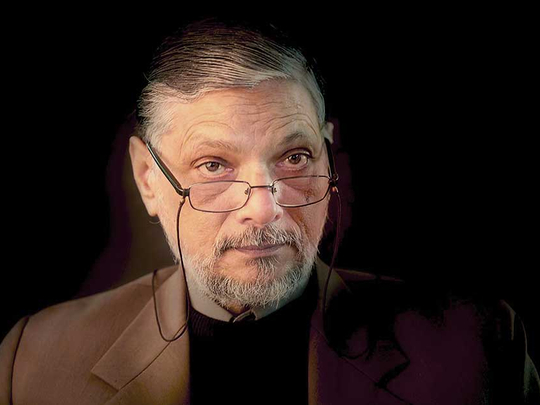
Lahore: There is something exciting about the place; you feel it as you climb the winding staircase and enter the first floor of the Mushtaq Gurmani Trust building in the Gulberg area of Lahore.
There is complete silence and you would not expect to see anyone there. But inside the large room, six students and their teacher are quietly at work. This is the studio of master painter of miniature art Bashir Ahmad, who is busy at work and from time to time guides his students, some of whom have come from far away places to learn the centuries-old art form.
The 63-year-old maestro works from Monday to Friday, between 11am and 5pm, in this studio. With nearly four decades of experience behind him, Ahmad has discovered countless variations in miniature artwork. After mastering traditional Mughal miniature art, he evolved it by using contemporary techniques.
He has exhibited extensively within the country and abroad, and is recognised worldwide for his exceptional command over traditional techniques of miniature painting.
Ahmad is best known for his contribution to the first-ever curriculum in the world for a Bachelor’s degree programme for miniature painting at the National College of Arts in 1983. His legacy continues to this date as his students have also exhibited their artworks in world-famous art galleries. His student Shazia Sikander is a pioneer of miniature art in the west. She is the first Pakistani artist to win the American State Award in 2012. Imran Qureshi, another student, is an internationally acclaimed artist.
Present in his studio when I visited were Lahore-based students in addition to Saima Munawar from the UK, and Shah Abdullah, Razia Shah and Shukriya Khan from Quetta.
“The biggest legacy of my commitment to the miniature painting [art form] is that famous names of the contemporary miniature artists [who] are my students or they know the work I have done in miniature paintings,” he said in an interview.
He was born in Lahore in 1954. He obtained the National Diploma of Arts in 1974 from the National College of Arts and later started teaching there. He revived the specialisation in miniature painting with Munhall Court painters’ descendant Shaikh Shuja Ullah and from Haji Sharif of Patiala Gharana.
Ahmad undertook formal training for the restoration of traditional Mughal, Persian, ivory and contemporary miniature paintings including those in the mediums of oil and water colour from his master, Shaikh Shuja Ullah, for nine years, from 1971 to 1980.
Bashir qualified for his Master’s Degree in Fine Arts from Punjab University in painting, printmaking and sculpture in 1985.
He has also served as the Principal and Head of Fine Arts Department in the National College of Arts (NCA).
“I never forget the teachings of the Shaikh Shuja Ullah, who learnt the miniature art from Mir Ali of Iran. It is his legacy which is I am continuing till date. No students can surpass the complexity of miniature painting without a master,” Ahmad said.
“I used the knowledge of nine years of my training from my teacher to make a curriculum for fine arts in miniature paintings. The journey was not easy. I had faced many obstacles and people even laughed at me when I shared my idea of making a curriculum. I divided the degree into technique, style and structure.
“Miniature is completely indigenous art type of Subcontinent in which an artist has to show all the details of any artwork,” Ahmad said.
‘Court artists’
“The reason miniature art went into decline was because Mughal-era miniature painters kept the secret with them or pass[ed] the knowledge to their next generations. They were all court artists. The great knowledge of miniature paintings and drawings passed from generation to generation. I sought the knowledge of miniature paintings from teachers of [the] Patiala family. I transformed this knowledge in designing a curriculum,” Ahmad said.
“Miniature is our art and we should be proud of this fact. Steps must be taken by both [the] private and public sectors to promote this magnificent art,” he added.
Ahmad has to his credit marvellous artworks that include miniature paintings, acrylic painting, graphite drawing and landscape painting. One of his paintings depicts a village outside the city of Lahore.
Ahmad’s work’s characteristics reflect those that were produced by elite painters in the courts of the Mughal emperors. “Miniature painting, as we know it today, provides an artistic variety that hails from the early civilisation to the present day, and has evolved over the years to become a combination of several cultures and traditions,” Ahmad explained.
“The genre of miniature painting took a major turn during the mid-16th century when the Mughals urged their court painters to shift their imaginative acumen into high gear and resort to a more baroque illustration.
“The necessary change of expression gave miniature painting its much-needed rejuvenation, which resulted in revolutionary concepts, improved compositions, better modelling and subtle addition of perspective,” he said
Ahmad has done restoration work on oil paintings by legendary artists Allah Baksh and Chugthai as well. “Restorations itself is a vast field and you have to work in accordance to the environment and with local material. I have restored 110-years-old door in NCA,” he said.
Field work
These days he is working on restoration of artworks by the legendary painter Shakir Ali, which are placed in Shakir Ali Museum. Even though he is getting old, his zest to share what he has learnt from the master and what he has developed in the field of miniature art know no bounds. He has received many of the top awards of Pakistan but his real reward comes in the form of respect he has earned among the artist community. No doubt he is a living legend.











